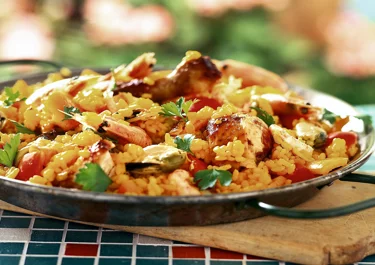
Paella

Instructions
Paella
Ingredients
Yellow onion | 1 |
|---|---|
Garlic cloves | 2 |
Butter for frying | 14⅖ g |
Saffron | ¼ g |
Arborio rice | 200 g |
Water | 500 ml |
Chicken stock | 45 ml |
Butter | 40 g |
Lime fruit, squeezed juice | 1 |
Sambal oelek | 1 tsp |
Large prawns with shell | 500 g |
Grilled chicken | 1 |
Pepper | 1 |
Tomatoes | 3 |
Mussels, canned | 225 g |
Coarsely chopped fresh parsley | 13 g |
The most quintessential Spanish dish
Vibrant and colourful with a cuisine that is as fantastically flamboyant as its culture: there are many reasons why Spain is the second most popular tourist destination in the world. This authentic paella recipe will transport you to the heart of Valencia with saffron-tinted rice, delicately sweet seafood, and fresh vegetables in every satisfying bite.
Spain’s unofficial national dish
Named after the paellera pan, the dish originated in Valencia, one of Spain’s major rice producing regions on the east coast. As the story goes, local farmers would create the dish from rice and other easily accessible ingredients like rabbit, snails, tomatoes, and onions. It quickly spread beyond the rice fields with chicken and fresh seafood soon added as star ingredients. Today, many consider it Spain’s national dish with few disagreeing that it is, by far, the country’s most popular culinary creation.
Drinks that go well with paella
For an authentic Spanish experience, pair your feast with a sweet and fruity sangria or crisp Cava as a bubblier and elegant alternative. White or red wine also compliment the dish very well and, as the second largest wine producer in the world, you won’t have to look far for the perfect local match. For an equally satisfying alcohol-free pairing, try granizado de limón (iced lemonade) or a non-alcoholic sangria.
Seafood paella and other variations
Traditionally speaking, there are three main types: the original paella valenciana that includes rabbit, chicken, duck and/or snails; paella de marisco that features seafood; and paella mixta which is a surf and turf combination.










